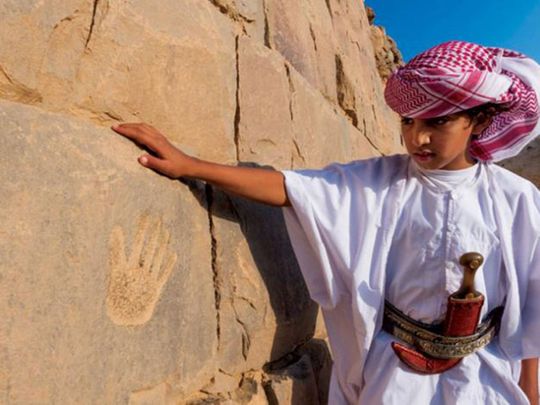
Abu Dhabi: Saudi Arabia’s Najran is famous for its historical and archeological sites, which are rich with ancient inscriptions and writings.
The inscriptions narrate the stories of consecutive civilizations, which continue to stand after thousands of years.
Mount Hama is one of those sites, and it is being prepared to be included in the World Heritage List.
The origins of Najran civilisations dated back, according to the last archaeological discoveries, to the Upper Paleolithic era. Researchers found traces of human civilization dating back to that period, and the impact of very ancient lakes that faded into the present era, indicating that that area located in the arms of the Empty Quarter had historical significance, which made it a focal point in the struggle of the ancient Arab kingdoms, wishing to control that green oasis, whose location is of economic importance as a key passage for one of the most important ancient trade routes.
A corridor of civilisations
Najran’s strategic location contributed to being a passage for the tribes of West and Central Arabia, as it was distinguished by its existence among countries with civilizations, which made it an important centre through the ancient trade route, heading to the northeast of the Arabian Peninsula, up to Mesopotamia, or Makkah Al Mukarramah, Madina and Al Ula, and then Petra, the Levant and Egypt.
The region has important monuments and sites dated back to the Byzantine, Umayyad and Abbasid periods, all of which confirm that the region was an important commercial and agricultural site, and of remarkable cultural depth.
The Hima Archaeological site in the Najran region is the largest site of rock carvings in the Kingdom, and is located in the north of Najran, about 130km, containing a number of archaeological sites such as the Sidah mount, the Hima mount, the Ain Jamal site, Shasa site and the Planet site, which are filled with inscriptions and drawings that were the first human attempts to write the ancient alphabet.
The inscriptions and rock drawings on this site were a historical testimony to the attempts of man to write the alphabet, which was known as the “Southern Musnad Calligraphy” and those who used to record their memoirs by the “Al Thamudi” and “Southern Musnad” calligraphy, along the road and around the caves, and in the foothills of the mountains at the Hima wells.
Saudi-French excavation expedition
A Saudi-French mission uncovered a large number of various rock inscriptions and drawings, including the human and animal ones, whose subjects also diversified to reflect aspects of human life in those eras, such as hunting, war and dancing as well as the method of engraving and colouring.
The team also uncovered an inscription with the “calligraphic line” in which a mention of the tribe of Tassem for the first time in ancient Arabic inscriptions, as well as a group of early Arabic inscriptions dated 470 AD, and revealed a rock drawing of a group of elephants. This drawing is the first appearance of elephant drawings in the Arabian Peninsula.








